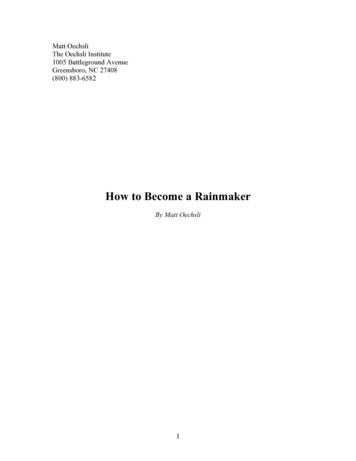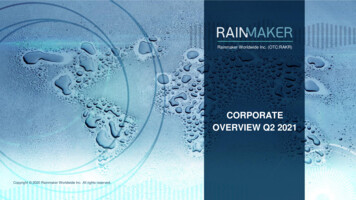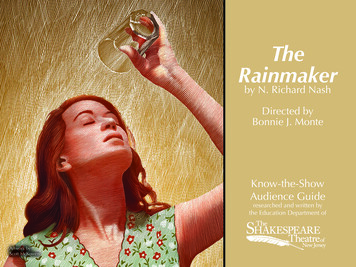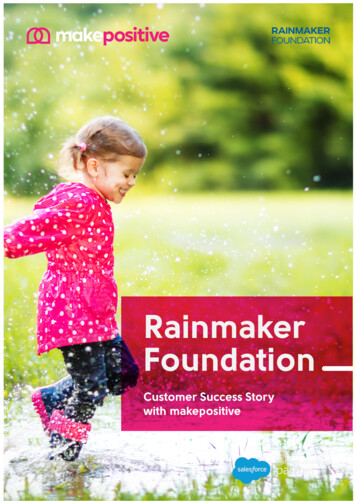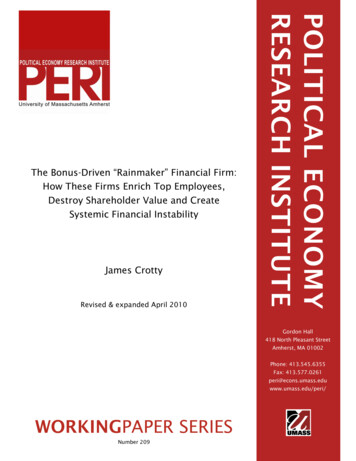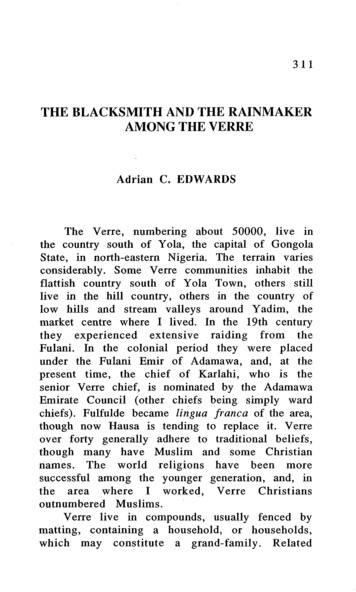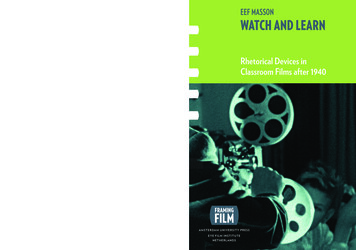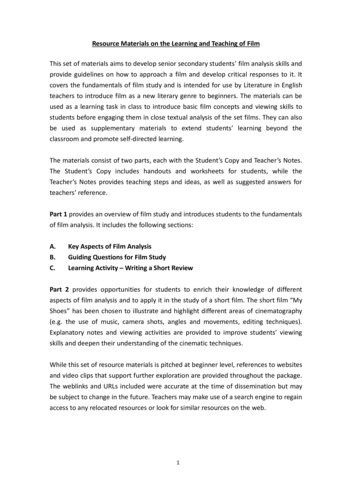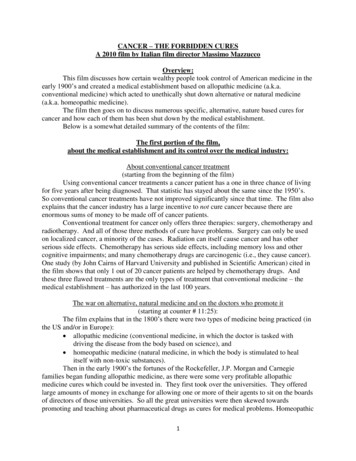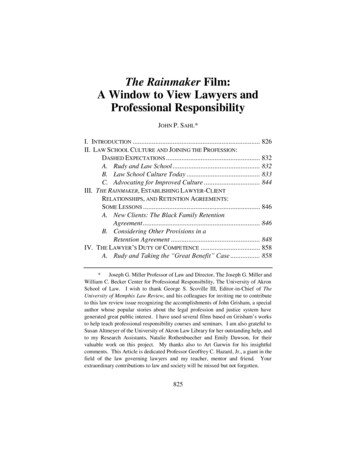
Transcription
The Rainmaker Film:A Window to View Lawyers andProfessional ResponsibilityJOHN P. SAHL*I. INTRODUCTION . 826II. LAW SCHOOL CULTURE AND JOINING THE PROFESSION:DASHED EXPECTATIONS . 832A. Rudy and Law School . 832B. Law School Culture Today . 833C. Advocating for Improved Culture . 844III. THE RAINMAKER, ESTABLISHING LAWYER-CLIENTRELATIONSHIPS, AND RETENTION AGREEMENTS:SOME LESSONS . 846A. New Clients: The Black Family RetentionAgreement . 846B. Considering Other Provisions in aRetention Agreement . 848IV. THE LAWYER’S DUTY OF COMPETENCE . 858A. Rudy and Taking the “Great Benefit” Case . 858* Joseph G. Miller Professor of Law and Director, The Joseph G. Miller andWilliam C. Becker Center for Professional Responsibility, The University of AkronSchool of Law. I wish to thank George S. Scoville III, Editor-in-Chief of TheUniversity of Memphis Law Review, and his colleagues for inviting me to contributeto this law review issue recognizing the accomplishments of John Grisham, a specialauthor whose popular stories about the legal profession and justice system havegenerated great public interest. I have used several films based on Grisham’s worksto help teach professional responsibility courses and seminars. I am also grateful toSusan Altmeyer of the University of Akron Law Library for her outstanding help, andto my Research Assistants, Natalie Rothenbuecher and Emily Dawson, for theirvaluable work on this project. My thanks also to Art Garwin for his insightfulcomments. This Article is dedicated Professor Geoffrey C. Hazard, Jr., a giant in thefield of the law governing lawyers and my teacher, mentor and friend. Yourextraordinary contributions to law and society will be missed but not forgotten.825
826The University of Memphis Law ReviewVol. 48B. Competency: The Model Rules . 859C. Falling Short of Competence . 860V. AMBULANCE CHASING: COMMUNICATIONSWITH NONLAWYERS . 867A. Rudy and Deck’s Trip to the Hospital . 867B. Limitations on Soliciting Clients . 868VI. THE SUPERVISORY OBLIGATIONS OF LAWYERS . 878A. Model Rules on Supervisory Obligations . 878B. Rudy and Bruiser’s Supervision. 881VII. CONCLUSION. 886“Cinema is a mirror by which we often see ourselves.”Alejandro Iñárritu, film director 1I. INTRODUCTIONThe use of stories, narratives, and literature to explore the moraland ethical dilemmas that lawyers and others face in their professionaland personal lives is not new. 2 Popular culture today offers a steadysupply of stories about lawyers, their work, and related ethicaldilemmas in film, television, and other media. These media depictionsprovide excellent opportunities for students to examine the work andethical dilemmas of lawyers in a variety of contexts. 3 Teachers can1. Dave McNary, Alejandro Inarritu on Diversity Push: “These Changes iversity-oscars1201687041/.2. See Carrie Menkel-Meadow, Telling Stories in School: Using Case Studiesand Stories to Teach Legal Ethics, 69 FORDHAM L. REV. 787, 788–89, 788 n.4 (2000)(noting that using “stories, literature, and narratives as tools for teaching readers aboutmorality and ethics began long ago, outside the realm of law” and reporting that“literary critics attribute the first use of narrative for moral or political purposes toPlato” (citations omitted)).3. See Carrie Menkel-Meadow, Can They Do That? Legal Ethics in PopularCulture: Of Character and Acts, 48 UCLA L. REV. 1305, 1307, 1311 (2001) (“[Some]depictions of [modern] lawyers in popular culture are actually extremely effectiveexemplars of legal ethics from which we can teach and learn much.”). For an exampleof using film to teach another subject, see Mary Kay O’Malley, Through a DifferentLens: Using Film to Teach Family Law, 49 FAM. CT. REV. 715, 715 (2011) (“[F]ilm
2018The Rainmaker Film827use these opportunities to help students understand the complexities ofthe lawyer’s role, including the lawyer’s work and ethical obligations,while assisting students to develop constructs for resolving thesedilemmas in the future. 4I began using the film To Kill a Mockingbird many years agoas a tool to help teach the basic Professional Responsibility (“PR”)course. 5 Near the beginning of the first class, I showed AttorneyAtticus Finch’s powerful closing argument in the trial of TomRobinson, an African-American facing a rape charge. 6 I also showedthe scene in which African-Americans in the courthouse balcony roseto recognize Atticus Finch’s passionate defense of Tom Robinson. 7The film excerpts engaged student attention, facilitated classroomdiscussion, and underscored the importance of learning about lawyersand their professional responsibility. 8 In short, the film provided aneffective and rewarding teaching experience.is particularly effective for learning and exploring the dynamics of humanrelationships at the center of family law cases.”).4. See infra Section II.B.5. The American Bar Association (“ABA”) requires all accredited lawschools to offer a course in PR or ethics. AM. BAR ASS’N, ABA STANDARDS ANDRULES OF PROCEDURE FOR APPROVAL OF LAW SCHOOLS 2017–2018, at a/publications/misc/legal lofLawSchools/2017 2018 standards chapter3.authcheckdam.pdf. This is often a three-credit-hour, semester-long course that coverslawyer and judicial conduct rules, disciplinary standards, professionalism concepts,the attorney-client evidentiary privilege, and other statutory and regulatory lawgoverning lawyer behavior. My goal in using the To Kill a Mockingbird film is toencourage students to reflect on their reasons for wanting to become lawyers whilehighlighting the important role that lawyers can play in our society. I note in classthat Atticus Finch’s defense of Tom Robinson has inspired many lawyers to fight forjustice and others to consider joining the profession. See, e.g., Stacy Caplow, Still inthe Dark: Disappointing Images of Women Lawyers, 20 WOMEN’S RTS. L. REP. 55,55 (1999) (“For many of us, Atticus Finch, the principled hero of the movie To Kill aMockingbird, was our first positive legal role model. . . . [I]t was the dignified,sagacious, and unquestionably humane Gregory Peck on the screen, who educated usabout what a lawyer was supposed to be [and motivated us] to go to law school andbecome a lawyer just like him.” (footnotes omitted)).6. TO KILL A MOCKINGBIRD (Universal Pictures 1962).7. Id.8. Student evaluations at the end of the course commonly note that studentsliked the use of films in the course.
828The University of Memphis Law ReviewVol. 48I still begin my first PR class of the semester with these filmexcerpts from To Kill a Mockingbird. I have since added the dramaticscene where Atticus sits outside of the local jail at night to protect hisclient from a vigilante mob seeking to lynch his client. 9 After viewingall of the excerpts, I ask students to consider what kind of lawyers theyhope to be and how they would like to be remembered. Studentsvolunteer that they would like to emulate Atticus Finch and berespected advocates for justice and the rule of law. I refer to theseexcerpts and our related class discussion several times throughout thesemester, usually to remind students of their wish to be like AtticusFinch. Sometimes I simply ask: “How do you think Atticus Finchwould act or handle this matter?” This question brings the class fullcircle, returning to our first class discussion about the important rolelawyers play in our society and how they can promote social justice.Given my positive experience teaching PR with To Kill aMockingbird, I have experimented using excerpts of other films in myPR class. This Article focuses on one such film, The Rainmaker, 10based on John Grisham’s popular novel with the same title publishedin 1995.11 The Rainmaker provides fertile ground for teachers to9. TO KILL A MOCKINGBIRD, supra note 6. The total amount of time devotedto showing the film, including the jailhouse scene, is less than 25 minutes. The classdiscussion may take another 10 to 15 minutes for a maximum total of 40 minutes.Students are emotionally connected to the powerful narrative of racial injustice andthe difficult sacrifice and courage needed by the lawyer to do the right thing indefending the accused. I note in class that I use the film to convey an importantmessage that, although we will focus often on technical professional conduct rules,the class should not lose sight of bigger, more fundamental concerns about moralityand courage—what I like to refer to as “doing the right thing.” For example, underthe Model Rules of Professional Conduct (“Model Rules”), Atticus Finch did not haveto defend Tom Robinson. Students seem to appreciate my noting of these bigger,fundamental concerns and the need to do the right thing.10. The film was released in 1997 and was directed for Paramount Pictures bythe five-time Academy Award winner Francis Ford Coppola, starring Matt Damon,Clare Danes, John Voight, Danny DeVito, Mary Kay Place, and Mickey Rourke.Other films based on John Grisham’s books include: The Runaway Jury (2003), ATime to Kill (1996), The Chamber (1996), The Client (1994), The Firm (1993), andThe Pelican Brief (1993). I only use material from the film for teaching my PRcourse, rather than including material from the book.11. Both the film and the novel garnered significant acclaim in the film andpublishing industries and with the public at large. See Todd McCarthy, 00
2018The Rainmaker Film829discuss a variety of ethical issues while simultaneously highlightingrelated professional responsibility doctrines for addressing thosechallenges. 12The film tells the story of Rudy Baylor, a recent Memphis StateLaw graduate, 13 who is desperately seeking employment in Memphis,Tennessee. 14 He finally acquires a job at the J. Lyman Stone Law Firmrun by Bruiser Stone, a corrupt, yet successful, personal injurylawyer. 15 Rudy meets Deck Shifflet, 16 the firm’s “paralawyer,”17 whoteaches Rudy about ambulance-chasing and other unethical ways topractice law. 18 As a new associate, Rudy’s job, in part, entails hn-grisham-s-the-rainmaker111732352/.As carefully constructed, handsomely crafted and flavorsomelyacted as a top-of-the-line production from Hollywood’s classicalstudio era, Francis Ford Coppola’s screen version of “JohnGrisham’s The Rainmaker” would seem to represent just about all afilmmaker could do with the best-selling author’s patented dramaticformulas without subverting them altogether. . . . [T]his story of ayoung Southern lawyer taking on an evil insurance giant exerts analmost irresistible David and Goliath appeal, and proves absorbingfrom beginning to end. Paramount release looms as a highly durableB.O. entry.Id. Both were also commercial successes: the New York Times Fiction Best SellerList featured the book, and the film earned a total revenue of 45,916,769. BestSellers, N.Y. TIMES (June 4, 1995), s-june-4-1995.html?pagewanted all; The Rainmaker (1997), THE r-The#tab summary (last visitedMay 18, 2018).12. See Lonnie T. Brown, Jr., “Lawyers” Not “Liars”: A ModifiedTraditionalist Approach to Teaching Legal Ethics, 51 ST. LOUIS U. L.J. 1119, 1129(2007) (discussing The Rainmaker as a vehicle for facilitating a “lively andentertaining discussion” about ethical issues and “making the lesson memorable” forstudents).13. Memphis State University College of Law has since been renamed to TheUniversity of Memphis Cecil C. Humphreys School of Law.14. THE RAINMAKER at 0:00:39–0:02:00 (Paramount Pictures 1997).15. Id. at 0:02:05–0:04:18.16. Id. at 0:04:38–0:04:47.17. Id. at 0:17:08–0:17:10.18. Id. at 0:15:37–0:19:14.
830The University of Memphis Law ReviewVol. 48new clients for the Stone firm to help cover his firm compensation. 19Rudy met his first client, the Black family, at a Memphis State Lawworkshop. 20 The client’s son, Donny Ray Black, is a young man dyingfrom leukemia and denied medical insurance. 21 The Black family suesGreat Benefit, a large insurance company, for bad-faith denial ofDonny Ray’s medical insurance claim. 22 Rudy must quickly takecharge of the Great Benefit case when the FBI arrests Bruiser, andBruiser subsequently disappears.23Great Benefit’s lawyerscontinually prey on Rudy’s inexperience and introduce him to the“rough and tumble” world of big-stakes litigation, which ofteninvolves tough and unfair conduct.24 Rudy’s interactions withcolleagues, clients, opposing counsel, and the judiciary reveal a culturethat often compromises or ignores the rules of professionalresponsibility. This case and the related lawyer conduct create an innerstruggle with Rudy’s conscience over right and wrong.This Article examines some of the film’s depictions of Rudy’sprofessional and personal exploits in hope of sensitizing students tosome of the ethical challenges or issues they may confront aspractitioners. In particular, this Article discusses my use of TheRainmaker to consider four ethical concerns and related rules in theModel Rules of Professional Conduct (“Model Rules”). 2519. Id. at 0:03:11–0:03:22 (“Now it ain’t exactly a salaried position. . . . Iexpect my associates to pay for themselves and generate their own fees.”).20. Id. at 0:07:47–0:07:57.21. Id. at 2:00:40–2:01:45.22. Id. at 2:01:48–2:02:45.23. Id. at 0:41:05–0:42:45.24. See id. at 1:00:40–1:04:45 (showing Great Benefit’s lawyers bullying Mr.Baylor when he travels to take depositions of Great Benefit employees).25. There are other ethical concerns in The Rainmaker besides these four, butthey are beyond the scope of this Article. For example, Deck Shifflet is a non-attorneyinvestigator who suggests to Rudy that they leave the J. Lyman Stone law firm andopen their own law office. Id. at 0:39:15–0:39:43. Deck states they could “spliteverything 50-50,” but this offer violates the Model Rule’s prohibition against alawyer sharing fees with a nonlawyer. Id. at 0:39:34–0:39:43. But see MODEL RULESOF PROF’L CONDUCT r. 5.4(a)(3) (AM. BAR ASS’N 2015) (permitting a lawyer or lawfirm to “include nonlawyer employees in a compensation or retirement plan, [that] isbased in whole or in part on a profit-sharing arrangement”). It is unlikely that Deckwas suggesting an arrangement under Model Rule 5.4(a)(3). In any event, Deck’soffer to “split everything 50-50” did not explicitly note that kind of arrangement.
2018The Rainmaker Film831In Part II of the Article, I briefly discuss Rudy’s sermon-likenarration at the beginning of the film that describes his reasons forbecoming a lawyer, his blunt criticism about law school culture, andhis job search. These are important topics and, like a lightning rod,Rudy’s narration attracts the class’s attention because many studentsshare Rudy’s sentiments about law school culture and seekingemployment in the law field. The strong student interest in thisdiscussion carries over to our subsequent examination of professionalresponsibility concerns in the film.Part III addresses the core ethics concerns of establishing alawyer-client relationship and negotiating and signing a professionalservices contract, commonly called a retention agreement, with aclient. Part III highlights some client-centered approaches for lawyersto implement to protect clients’ interests and promote informedconsent to the retention agreements.Part IV discusses how a lawyer can provide a client withcompetent representation and the lawyer’s overriding ethicalobligation to provide this representation. Part IV also discusses someimportant ways for Rudy to comply with this obligation and notespossible dire consequences for Rudy if he fails to provide competentcounsel.Part V deals with the concern of lawyers communicating withnon-clients and reviews the professional conduct rules governing suchcommunications. Part V notes the important distinction betweenlawyer in-person solicitation and permissible advertising. It also raisesthe notion that in-person solicitation bans may be unnecessary.THOMAS D. MORGAN & RONALD D. ROTUNDA, SELECTED STANDARDS ONPROFESSIONAL RESPONSIBILITY 90 (2016). Another ethical concern arguably involvesRudy’s representation of Kelly Riker after she is arrested for the murder of herhusband, Cliff Riker. THE RAINMAKER, supra note 14, at 1:32:25–1:34:00. Rudywas romantically involved with Kelly. Id. at 0:57:37–0:59:55. This raises thequestion of whether Rudy’s “personal interest” in Kelly would interfere with hisability to independently act in her best interests. See MODEL RULES OF PROF’LCONDUCT r. 1.7(a)(2); MORGAN & ROTUNDA, supra, at 26. In Chief DisciplinaryCounsel v. Zelotes, for example, the Appellate Court of Connecticut held that “the[defendant-attorney] violated rule 1.7(a)(2) by having a concurrent conflict thatcreated a significant risk that his representation of [his client, the wife, in a divorcecase] would be materially limited by his personal interest [in her, albeit nonsexual,]is fully supported by clear and convincing evidence . . . .” 98 A.3d 852, 865–66(Conn. App. Ct. 2014).
832The University of Memphis Law ReviewVol. 48Part VI considers a lawyer’s supervisory duties oversubordinate lawyers and nonlawyers. It is important for lawyers,especially new lawyers, to ensure that their conduct and the conduct ofothers in the law firm is compatible with a lawyer’s professionalobligations.Part VII concludes, maintaining that The Rainmaker offersteachers the significant prospect of helping students better appreciateimportant professional behavioral norms and ethics rules in the contextof the rigors of Rudy Baylor’s law school and lawyering experiences.II. LAW SCHOOL CULTURE AND JOINING THE PROFESSION: DASHEDEXPECTATIONSA. Rudy and Law SchoolThe Rainmaker begins with Rudy Baylor delivering a brief butengaging narration describing his inspiration to become a lawyer. 26Specifically, it was the civil rights lawyers in the 1950s and ’60s, andthe “amazing uses they found for the law.” 27 To Rudy, these lawyersdid something that most people thought was impossible: “They gavelawyers a good name.”28 Rudy’s narration occurs over a montage oflaw school life, ranging from Rudy studying in the library toclassmates enjoying a social event at a bar.29 Both Rudy’s narrationand the scenes present mostly a favorable view of lawyers and lawschool.In a subsequent narration, however, Rudy criticizes law schoolculture.30 He notes that in his first year of law school, he and his26. THE RAINMAKER, supra note 14, at 0:00:39–0:01:25.27. Id. at 0:00:54–0:01:02.28. Id. at 0:01:02–0:01:08. In addition to being inspired by the civil rightslawyers, Rudy may have had another personal reason for becoming a lawyer. Id. at0:00:39–0:00:53. “My father hated lawyers. All his life. He wasn’t a great guy, myold man. He drank and beat up my mother; he beat me up too. So you might think Ibecame a lawyer just to piss him off, but you’d be wrong.” Id.29. Id. at 0:00:39–0:02:00.30. Id. at 0:27:49–0:28:15. This narration occurs when Rudy has justcompleted the bar examination. Id.
2018The Rainmaker Film833classmates shared a common bond of being supportive of each other’sefforts to succeed in law school. 31In my first year of law school, everybody lovedeverybody else. Because we were all studying the law,and the law was a noble thing. By my third year, youwere lucky if you weren’t murdered in your sleep.People stole exams, hid research materials from thelibrary, and lied to the professors. Such is the nature ofthe profession. 32The earlier shared community of interests quickly dissipated asstudents aggressively and stressfully competed with each other tooutperform their classmates and pursue their individual self-interest.The film poignantly illustrates the intensity of this competition with astudent who hopes to gain an unfair advantage over classmates bytearing a page out of book to prevent them from accessing the samematerial.33 These scenes and narratives pique student attention, in part,because they readily recognize and share some of Rudy’s criticismsand related stress about law school culture.B. Law School Culture TodayI begin my examination of The Rainmaker with these scenesand narratives because the law school experience inevitably shapes, inpart, lawyers’ professional identities. 34 Rudy’s criticisms of law31. Id.32. Id.33. Id.34. See E. Scott Fruehwald, Developing Law Students’ Professional Identities,37 U. LA VERNE L. REV. 1, 1–2 (2015).A key responsibility of law schools should be to help their studentsdevelop professional identities—‘What it means to be a lawyer intoday’s world.’ . . . [A] focus on ethical formation require us toconsider not just what lawyers should know and what they shoulddo, but also who they should be in order to live out the best ideals ofthe profession. It requires us to envision our graduates as the lawyersthey will be. . . . While all law schools teach a course in legal ethics,only a few law schools go further and help their students cultivatetheir ‘selves’ within the legal profession . . . .
834The University of Memphis Law ReviewVol. 48school provide a nice entrée for students to discuss what law schoolexperiences and practices they feel promote (or undermine) being agood and ethical lawyer. I ask whether law school provides the kindof experience likely to produce future Atticus Finch-like lawyers. Ifnot, I ask how we can improve the existing law school experience andculture. I take this opportunity to remind students that scholars havewritten much on the topic of changing law school culture, 35 and Ibriefly identify a proposal for change by Professors Eli Wald andRussell Pearce (“Wald” and “Pearce”) concerning relational selfinterest.36Law school culture remains intensely competitive andconformist,37 which partially explains the students’ quick connectionto this part of the film. They have firsthand experience of this intensecompetition and the related feelings of stress and discomfort that stillId. (citations omitted); see also David I. C. Thomson, Teaching Formation ofProfessional Identity, 27 REGENT U. L. REV. 303, 303 (2015) (reporting the 2007landmark report on legal education by the Carnegie Foundation for the Advancementof Teaching (commonly known as the Carnegie Report) “focused its strongestcriticism” on the failure of law schools to devote “sufficient attention to the formationof professional identity in their students”).35. See, e.g., Michael I. Meyerson, Law School Culture and the Lost Art ofCollaboration: Why Don’t Law Professors Play Well with Others, 93 NEB. L. REV.547, 549 (2015) (exploring “the disconnect between the individualistic culture of lawschools and the collaborative culture of the legal community at large” and discussingthe benefits of changing the “individualistic law school culture” to a morecollaborative enterprise); John O. Sonsteng et al., A Legal Education Renaissance: APractical Approach for the Twenty-First Century, 34 WM. MITCHELL L. REV. 303(2007) (exploring approaches to the competitive and stress-inducing culture of legaleducation in the twenty-first century).36. Eli Wald & Russell G. Pearce, Making Good Lawyers, 9 U. ST. THOMASL.J. 403, 429–42 (2011).37. See Susan Sturm & Lani Guinier, The Law School Matrix: ReformingLegal Education in a Culture of Competition and Conformity, 60 VAND. L. REV. 515,549 (2007).The internal operating system of legal education integrates a theoryof law (cognitive and objective); a concept of professionalism(adversarial and neutral); and a view of education (competitive anduniform). When students and faculty share an institutional culturethat is organized around formalized and homogeneous measures ofsuccess, departures from that system of evaluation are necessarilymarginalized.Id.
2018The Rainmaker Film835resonate with them. 38 Student volunteers readily share their strongthoughts and experiences about the competitive nature of law schooland its other shortcomings. Sometimes the criticism provokescounterpoints, but typically there is broad consensus about thecorrosive effects of the competitive atmosphere in law school. Intoday’s digital age, it is less likely that students will tear pages out ofbooks to gain unfair advantages, but there are other ways to obtainunfair advantages regardless of today’s wired law school environment.For example, some students may seek the impermissible assistance ofclassmates in researching, writing, or editing papers, and somestudents will even plagiarize submissions.39 Other students may cheatby using prohibited materials while taking an examination orcontinuing to write after the examination period ends. 40Student comments reflect that one key cause of the intensecompetition in law school is the way law schools evaluate studentperformance. According to Professors Susan Strum and Lani Guinier,the metric for evaluation is simple: out-compete and out-rank yourclassmates.41 Most law schools have mandatory grading curves, which38. See Brent E. Newton, The Ninety-Five Theses: Systemic Reforms ofAmerican Legal Education and Licensure, 64 S.C. L. REV. 55, 80 (2012) (discussingthe “culture of cut-throat competition among law students”).39. For rules barring such conduct, see, for example, BOS. UNIV. SCHOOL OFLAW, 2017–2018 J.D. STUDENT HANDBOOK 43–45 (2017) (listing specific examplesof violations, including plagiarism) and UNIV. OF AKRON SCHOOL OF LAW, STUDENTHANDBOOK, STUDENT DISCIPLINARY CODE 21–22 (2009) (“[F]ailing to adequatelyidentity the extent of reliance on the work of another person.”).40. For rules addressing such misconduct, see, for example, BOS. UNIV.SCHOOL OF LAW, 2017–2018 J.D. STUDENT HANDBOOK 37 (2017) (“Students muststop writing and turn in in-class examination papers when time is called.”) and UNIV.OF AKRON SCHOOL OF LAW, STUDENT HANDBOOK, STUDENT DISCIPLINARY CODE 21–22 (2009) (“A student violates this Code if: . . . in any . . . matter related to the Schoolor legal profession, he or she seeks to obtain unfair advantage for himself, herself oranother.”).41. See Sturm & Guinier, supra note 37, at 537. The authors further argue thatlaw schoolsallocate[] value based on one’s place in the performance hierarchy:we are excellent because we are highly ranked; we are successfulbecause we have high LSAT scores or grades or make the mostmoney or have the greatest number of publications or citations.Performance is embedded in a success narrative that constrains andstructures every aspect of law school activity including admissions,
836The University of Memphis Law ReviewVol. 48inevitably means that some students will be at the top of the curve andothers at bottom. 42 This grading system promotes intense competitionand stress among classmates in a contest to surface at the top of thecurve.Students sometimes raise another concern about law schoolgrading and stress: professors often base grades on one end-of-thesemester examination. This examination provides a summativeassessment with little individual and formative feedback. 43 Studentsare frustrated by this grading approach and desire more feedbackduring and at the end of the semester. 44 On the other hand, moredetailed, individualized feedback is labor-intensive and time-faculty appointments and tenure, student assessment, resourceallocation and career counseling.Id.42. Lauren Carasik, Renaissance or Retrenchment: Legal Education at aCrossroads, 44 IND. L . REV. 735, 753–55 (2011).43. Id. at 753; see also Daniel Schwartz & Dion Farganis, The Impact ofIndividualized Feedback on Law Student Performance, 67 J. LEGAL EDUC. 139, 140(2017) (stating that “[f]or well over a century, students’ grades in most law schoolclasses have been based exclusively on their performance on a single end-of-semesterexam” with the notice of the letter grade occurring weeks after the exam and with no“individualized comments regarding their exam performance”).44. Paula J. Manning, Understanding the Impact of Inadequate Feedback: AMeans to Reduce Law Student Psychological Distress, Increase Motivation, andImprove Learning Outcomes, 43 CUMB. L. REV. 225, 227–28 (2013).Law student psychological distress has been attributed to a numberof concurrent causes—including the lack of adequate performancefeedback, which, in addition to being a stressor on its own,exacerbates the pressure caused by the competitive law schoolenvironment. Although most of the discussion about inadequacy offeedback has been centered on the dearth of feedback, infrequencyis not the only problem. Even when feedback is delivered, it is oftencomposed of controlling and non-informational statements—which,in addition to being of little instructional value, can lower studentmotivation, discourage persistence, and contribute to the decline inwell-being experienced by many law students. Such feedbackcontributes to the autonomy-thwarting educational environment thatis devastating for many students and fails to provide instruction thatis compa
Grisham's The Rainmaker" would seem to represent just about all a filmmaker could do with the best-selling author's patented dramatic formulas without subverting them altogether. . . . [T]his story of a young Southern lawyer taking on an evil insurance giant exerts an

